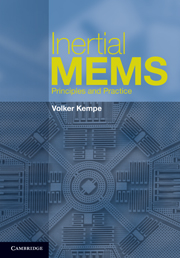8 - Gyroscopes
Published online by Cambridge University Press: 03 May 2011
Summary
The need to capture the relative rotation of a platform like a ship or an airplane led to the development of classical gyroscopes. Gyroscopes acquire angular orientations or their changes (rates) using Coriolis forces emerging within a rotating, non-inertial system of coordinates. Since the Earth rotates with a quite significant angular speed, any reference system connected to the Earth's surface is at best only an approximation of an inertial coordinate system. Therefore, navigation-orientated applications in aerospace and marine systems need correction for the Earth's rotation vector. However, for automotive, consumer, and biomedical applications the Earth's surface is a sufficiently good approximation of an inertial system.
Some basic principles
A classical gyroscope consists of a flying wheel, the large buoyancy of which, together with friction-compensating mechanisms, allows one to approximate its rotation as a force-free movement within an inertial space. If the platform rotates, the principle of conservation of angular momentum keeps the wheel's motion unchanged within the inertial system, causing the angular velocity vector to change orientation within the platform system. By observing this change, the platform's rotation angle can be derived. The same mechanism forces Foucault's pendulum to “draw” rosettes on the floor – the platform of the non-inertial, rotating system of the Earth's surface.
The relative motion of a body within the platform's system of coordinates can equivalently be described by using virtual entities like Coriolis forces or moments.
- Type
- Chapter
- Information
- Inertial MEMSPrinciples and Practice, pp. 364 - 459Publisher: Cambridge University PressPrint publication year: 2011
- 14
- Cited by



